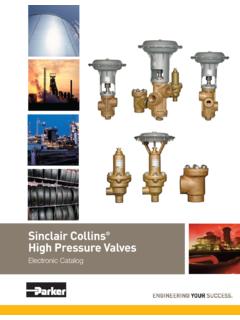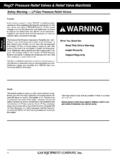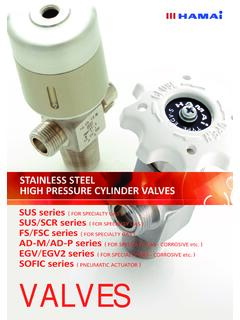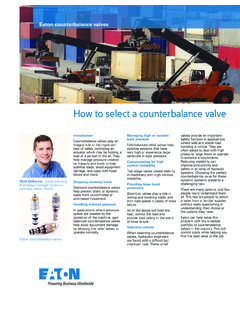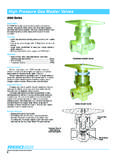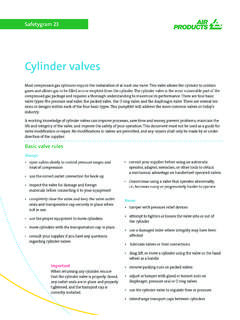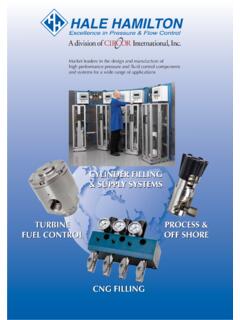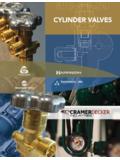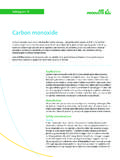Transcription of Pressure Safety Orientation - Fermilab
1 Pressure Safety OrientationFN 000000271/CRObjectives Make user familiar with terms and definitions Be aware of hazards associated with pressurized gas sources Identify components of pressurized gas systemsWhat This Course Will Not Do Qualify you to design, fabricate, or test Pressure vessels Authorize you to use oxy-acetylene equipmentAdditional training and experience isrequired. Contact your supervisor for Safety References Fermilab ES&H Manual (FESHM) FESHM 5031is Fermilab s Pressure Safety Reference. It contains: Responsibilities of Division/Section Heads, Mechanical Safety Subcommittee, and employees Process for design, fabrication, testing, and using Pressure vessels Requirements for Engineering Notes for all new and existing Pressure vesselsPressure Safety References FESHM 5031 also addresses design and documentation Pressure vessels and systems shall be designed and documented in accordance with FESHM 5031 and its appendices An Engineering Note is a written analysis demonstrating that a given vessel satisfies the requirements of this chapterPressure Safety References FESHM 5031 (Cont d)
2 Vessels that operate above 15 psi and have a minimum dimension larger than 6 inches requires formal engineering review Metallic silver sticker is attached when review is completePressure Safety References FESHM 5034( Pressure Vessel Testing) Requires all Pressure vessels to be tested to assure they can be operated safely Pressure tests performed & documented by outside manufacturer need no be repeated Requires testing permit to assure testing will be conducted safelyPressure Safety References FESHM ( Pressure Piping) Outlines procedures for designing, fabricating and testing Pressure piping systems Pressure Safety References Engineering Notes for Pressure Vessels FESHM 5031 Technical Appendix Contact List When you need further help and information contact your Senior Safety Officer Compressed Gas cylinder training Available on the TRAIN databaseDefinitions Qualified Person A person who has successfully completed this course ( Pressure Safety Orientation ) and the Compressed Gas cylinder TrainingDefinitions Maximum Allowable Working Pressure MAWP has a temperature for which it is valid Temperature should be noted on silver sticker or the vessel nameplateDefinitions Maximum Operating Pressure Set 10%-20% below QUESTION #1.
3 Can you safely operate at 150 % answerDefinitions Burst Pressure Pressure at which the vessel catastrophically fails, releasing its contents Question #2: Which is greater, the burst Pressure of a vessel or the MAWP? answerPressure Safety Program Concept All Pressure systems must be designed, tested, inspected, and used in accordance with sound engineering principles by qualified and trained personnel in accordance with FESHM 5031, , , , , , and Safety Program FESHM 5031 outlines policies, procedures, and requirements Mechanical Safety Subcommittee - responsible for recommending guidelines for the fabrication, testing, installation, and use of mechanical systems for experimental and laboratory applications. Senior Safety Officers provide daily guidance in program implementation Qualified Person YOUP ressure Safety the BasicsOperating Tips With high Pressure regulator always use gauge Low Pressure (psig) X high surface area (square inches) creates a lot of stored energy & force Use good design and compatible materials PVC is fine for low Pressure water, but not for compressed gases Know how to have a safe assembly Working Pressure gauge scale should be at least 120% of MAWPO perating Tips DO NOT mix oxygen and oil DO NOT misuse equipment Follow procedures Follow established procedures &/or Hazard Analysis See your supervisor if you have any questionsOperating Tips Always tie down hoses QUESTION #3: What is the weakest part of the hose?
4 Answer QUESTION #4: What can happen if a hose breaks? answer Get rid of dirty or damaged regulators Dirt in regulator can cause it to fail Lock and tag equipment - verify there is no pressureOperating Tips Get rid of dirty or damaged regulators Dirt in regulator can cause it to fail Lock and tag equipment any pressurized gas before working on system Verify there is no Pressure Pressurized gasses are stored energy See FESHM 5120 for informationAIR COMPRESSORSAir Compressors Most common Pressure vessels on site are air receivers Purchased with attached air compressor Make sure there is an ASME stamp Guarantees vessel was built in compliance with Pressure vessel code Vessels fabricated at Fermilab need: Engineering Note Pressure testingAir Compressors Relief valve must be installed so that vessel cannot exceed its design Pressure Valve is also ASME stamped Valve must be inspected every 3 years, tested or replaced every 6 years Valve must be able to relieve as much gas as the compressor can supply Question #5.
5 What happens if relief valve opens at 100 psi, but cannot pass as much gas as compressor is delivering answerAir Compressors Portable Compressor with Hot Dog Style Tank Operate at 125 psi Since vessel diameter is less than 6 inches, no formal review is required Does not require silver stickerAir Compressors Portable Air Receiver Vessel purchased without an attached compressor Pressurized with in-house compressor Vessel diameter is greater than6 inches, and operated at 100 psi, so it requires a formal reviewCYLINDERSC ylinder Design Design and use is per Department of Transportation (DOT) specifications Ex. DOT 3AA Standard 2000 psig cylinder has cubic feet of water volume (~200 standard cubic feet of gas) Standard cylinder is 9 outside diameter and 50 high Cylinders are NOT intended to be used or stored in areas > 125 degrees F Cylinders need to have regulator attached before useCylinder Relief Devices Relief Device must be compatible and never modified!
6 !!Frangible DiscUsed with CO2, N2, O2, Ar, HeDoes NOT reseal when Pressure goes downFrangible Disc Backed by Fusible MaterialUsed with Hydrogen, CH4 Common Gas cylinder : (a) hand wheel, (b) CGA outlet connection, (c) Pressure relief outlet specification (3AA is the size) and service Pressure (2,265 psig) s symbol (MC) Date for Vendor only includes original tester s capCylinder Identification DOT Shoulder Labels is the only method to identify what s in cylinder Tags are not always reliable Beware of mislabeled equipment DO NOT Depend on Color Codes There is no standardizationShoulder Labels Shoulder label is required for documentation, accountability, and tracking Label contains information on: Chemical content Health hazards ReactivityStatus Tags Status tags identify whether cylinder is full, in service, or has residual pressureProper Handlings and Transporting ALWAYS move or transport cylinder with regulator off and protective cap installed Especially in pickup trucks!
7 ALWAYSuse hand truck, forklift truck, cylinder pallet system and procedures established by your division/section Use cylinder carts NOT YOUR BACK When lifting with crane - use lifting fixture Do not sling individual cylindersCylinder Caps Protect valvewith cylinder cap Caps come off easily ---DO NOTlift by the cap QUESTION #6: If cap is stuck, can you loosen with penetrating oil? answerProper Use of Cylinders ALWAYS secure cylinder Except when moving it Use chains or straps (2/3 of the way up) Use storage racks Back out adjusting handle on a regulator before opening the cylinder valve to reduce pressureProper Use of Cylinders Leave some residual gas in cylinder Typically ~20 psi ONLY vendors can refill vendor-owned cylinders If cylinders are corroded or appear damaged, send back to vendorCylinder Storage Separate full from empty cylinders Separate oxidizers from flammables by AT LEAST 20 feet or a hour fire wall Store cylinders upright Keep out of direct sunlightCylinder Storage Chain/strap cylinders Don t put cylinders in walkways Provide clear warning signs for toxics and corrosives Notify SSO for storage requirements for toxics QUESTION #7.
8 When can you store cylinders side by side? answerPropane Cylinders Cylinders come in 3 sizes1. On torches (14 16 oz.) When empty, dispose of cylinder2. Grill & Campers (20#) Can refill cylinder , but only with propane Cylinders are refilled by vendor3. Fork Trucks (~65#) Available in stockroom Refilled by vendorCylinder valves Do not attempt to fix valve Never remove cylinder valve! cylinder valve is installed by vendor cylinder valve is matched to gas contained insideLecture Bottles and Sample Cylinders Typically 15 long x 2 diameter, 500 cc Used for samples or specialty gases DOT Non-returnable hence no retest required User is responsible to properly identify and dispose of the contentsEmpty Cylinders ALWAYS leave some positive Pressure to keep cylinder clean Leave about 25 psi and not less than 20 psi Except acetylene cylinders which are only pressurized to 15 psi to begin with Use acetylene cylinders until empty More information is found in CGA Handbook and Compressed Gas cylinder Safety trainingCylinder Corrosion The bottom of the cylinder get the most corrosion If cylinderappears corroded.
9 Sendback to vendorPRESSURE PIPING SYSTEMSP ressure Piping Systems Piping systems contain very large volumes resulting in much stored energy Piping systems need to be fitted with relief valves to prevent Pressure exceeding the MAWP Consult your supervisor or SSO for Lockout/Tagout procedures before working on any piping systemREGULATORS & MANIFOLDSM anifoldsManifolds are the bridge between source gas and end useFunctions of Regulators Regulate delivery Pressure Protect from overpressure Indicate value of Pressure - gauge Vent unused excess gas Throttle (meter) gas into its end useThe man suddenly found himself with a jet-propelled 215 pound piece of steel. He wrestled it to the floor, but was unable to hold it. The cylinder scooted across the floor hitting another cylinder , knocking it over and bending its valve.
10 The cylinder then turned 90 degrees to the right and traveled 20 feet where it struck a painters scaffold causing a painter to fall 7 feet to the floor. After spinning around several times, it traveled back to its approximate starting point, where it struck a this point, the cylinder turned 90 degrees to the left and took off lengthwise of the room chasing an electrician in front of it. It crashed into the end wall 40 feet away breaking four concrete blocks. It turned again 90 degrees to the right, scooted through a door opening, still chasing the electrician. The electrician ducked into the next door opening, but the cylinder continued its travel in a straight line for another 60 feet, where it fell into a truck well striking the truck well door. The balance of the cylinder Pressure was released as the cylinder spun harmlessly around in the truck well area.
